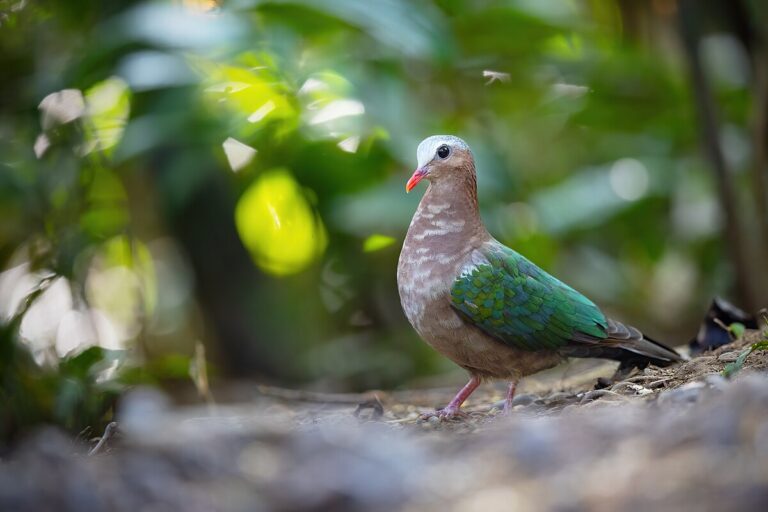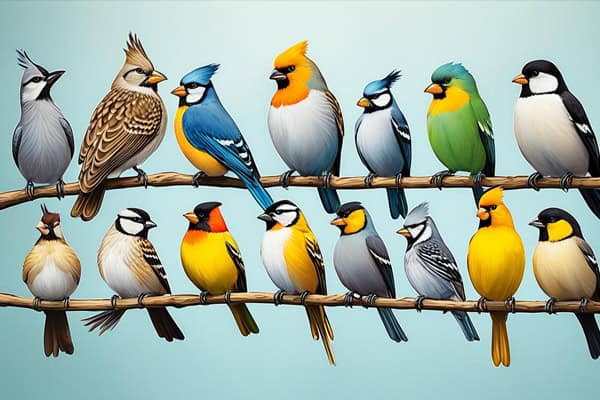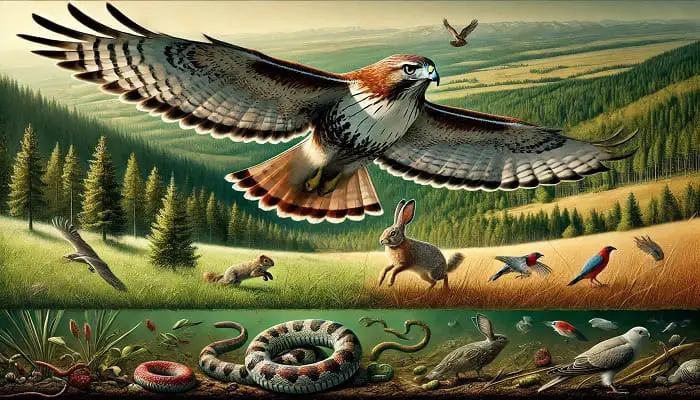7 Brown Birds With Red Heads (With Pictures & Guide)
Have you pondered on small brown birds that have red heads? Why are they so captivating? We’re going to look at brown birds with red heads in our quick guide. We’ll uncover the reasons behind their intriguing looks.
Birds like red crossbill and the northern cardinal are amazing at adapting to varied habitats. Their beautiful colors, interesting behavior and favorite places to live, make them nature’s marvels. Anyone interested in birds or just wondering about them, come along. Let’s discover more about these charming brown birds with red heads.
Key Takeaways:
- Discover the unique characteristics and physical features of brown birds with red heads.
- Learn about the fascinating behaviors and habits of these avian creatures.
- Explore the preferred habitats and range of these captivating birds, including the common habitats of the purple finch and the red-headed woodpecker.
- Gain insights into the significance and possible evolutionary reasons behind their red heads.
- Expand your knowledge of specific species, including the Common Redpoll, Acorn Woodpecker, Western Tanager, Pyrrhuloxia, House Finch, a species of birds notable for their vibrant red feathers., Vermilion Flycatcher, and Red-faced Warbler.
Here Are 7 Beautiful Brown Birds With Red Heads
1. Common Redpoll
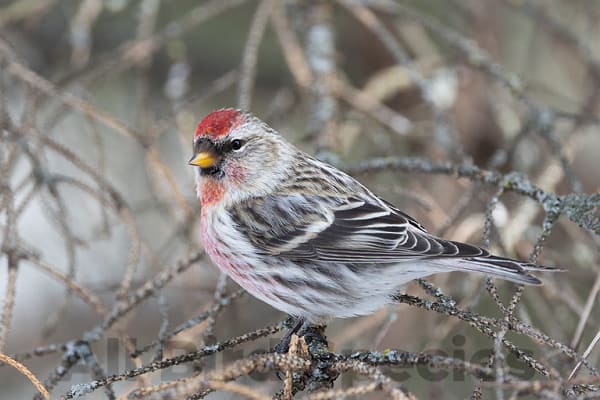
The red-headed woodpecker is recognized for its bright red patch, distinguishing it from other species. Common Redpoll is a notable brown bird with a redhead, ranking at #15 on our list of birds with redheads. This small finch, often mistaken for the more common purple finch or the northern cardinal, is known for its distinctive appearance and fascinating behaviors that set it apart from other red-headed birds.
Physical Features:
- The Common Redpoll measures approximately 5.5 to 6 inches in length, with a wingspan of 9 to 10 inches.
- It has a brownish body and a bright red cap on top of its head, which contrasts beautifully against its black bib.
- The red head of the Common Redpoll is more subtle compared to other red-headed birds on our list, but it is still a defining feature of this species.
Habitat and Migratory Patterns:
The Common Redpoll is a migratory bird that breeds in the Arctic regions of North America, including Alaska and Canada. During the winter, it, along with the northern cardinal, can be found in northern regions of the United States.
“The Common Redpoll is known for its ability to survive in cold and harsh environments, thanks to its unique adaptations.”
Their preferred habitats of these small brown birds with red heads include open coniferous and mixed forests, as well as shrubby tundra. They are often seen in flocks, foraging for food in trees and shrubs, and can also be attracted to backyard feeders.
Interesting Facts:
- The Common Redpoll has a specialized beak that allows it to extract seeds from the cones of trees such as spruce, pine, and birch.
- During winter, its diet mainly consists of seeds, but it will also feed on insects and berries during the breeding season.
- The male Common Redpoll has a beautiful song that is often described as a cheerful jumble of trills and warbles.
Table: Comparison of Common Redpoll with Other Red-headed Birds
| Bird | Physical Features | Habitat | Migratory Patterns | Main Food Source |
|---|---|---|---|---|
| Common Redpoll | Brown body, red cap, black bib | Arctic regions, coniferous forests, shrubby tundra | Migratory, breeds in the Arctic, winters in northern US | Seeds, insects, berries, and acorns, are favored by many birds such as the purple finch and the red-headed woodpecker. |
| Acorn Woodpecker | Black body, white face, red crown | In Western North America, oak forests | Non-migratory, resident throughout the year | Acorns, insects |
| Western Tanager | Yellow body, black wings, redhead | Western North America, coniferous forests | Migratory, breeds in North America, winters in South America | Insects, fruits |
As seen in the table above, the Common Redpoll has a unique combination of physical features, habitat, migratory patterns, and food sources that distinguish it from other red-headed birds.
2. Acorn Woodpecker
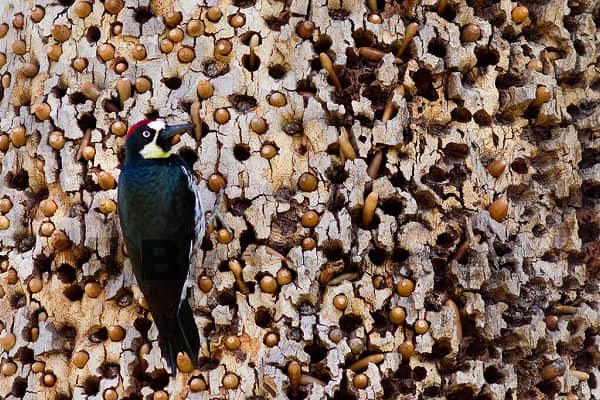
Get ready to be amazed by the Acorn Woodpecker, a fascinating brown bird with a vibrant red head and breast. This unique species is known for its distinctive appearance and captivating behaviors. Let’s delve into the details and explore the world of the acorn woodpecker together.
Feeding Habits
The acorn woodpecker has a diverse and specialized diet that primarily consists of acorns. They are known for their remarkable ability to store thousands of acorns in “granary” trees, creating a reliable food source, especially during the winter months. In addition to acorns, they also feed on insects, fruits, and tree sap.
Social Behavior
The acorn woodpeckers, comparable in social structure to the purple finch, are highly social birds, often living in large family groups. They exhibit cooperative breeding, with multiple adults helping to raise the young. Their breeding system is unique, involving a dominant breeding pair and several non-breeding “helpers” who assist with nesting duties.
Did you know? The red crossbill has a unique beak adapted for extracting seeds. Acorn woodpeckers are known for their communal roosting behavior, where numerous individuals gather and sleep together in tree cavities or granary trees.
Habitat and Distribution
The acorn woodpecker is mainly found in oak woodlands and mixed conifer forests of western North America. This species can be spotted in California, Oregon, Arizona, and parts of Mexico. They prefer areas with abundant oak trees, as this is where they find their primary food source, acorns, much like the Pileated Woodpecker.
Spotting the Acorn Woodpecker
If you’re interested in observing the acorn woodpeckers in the wild, look for them in oak-dominated forests, wooded parks, or even urban areas with mature trees. They can often be seen excavating tree cavities or creating their unique “granaries”, where they store acorns.
| Characteristics | Description |
|---|---|
| Size | Approximately 8.5 inches (21.5 cm) in length |
| Coloration | Black and white body with a vibrant red crown and throat |
| Distinctive Marks | White eyes, black face, and a white patch on the lower back |
| Behavior | Active and noisy, frequently heard vocalizing with distinctive calls and rattling sounds |
The acorn woodpecker is truly a unique and captivating bird with its striking redhead and intriguing behaviors. Whether you’re a seasoned birdwatcher or just beginning your journey, encountering an acorn woodpecker in the wild is an experience you won’t soon forget.
3. Western Tanager

When it comes to visually stunning avian species, the Western Tanager tops the list. This beautiful brown bird captures attention with its vibrant plumage and striking redhead. From its unique appearance to its fascinating behaviors, there’s much to discover about this captivating species.
Plumage and Physical Features:
The Western Tanager features a rich combination of colors that set it apart from other birds. Its body is predominantly brown, with bright yellow underparts and striking black wings. The most eye-catching feature is its reddish-orange head, which adds a pop of color to its overall appearance. Adult males boast the most vibrant redheads, while females and juveniles exhibit a softer yellowish hue.
Breeding Habits and Migratory Patterns:
During the breeding season, Western Tanagers can be found across western North America, from the Pacific Coast to the Rocky Mountains. They prefer coniferous forests and open woodlands as their nesting habitats. These birds are neotropical migrants, meaning they journey to Mexico and Central America to spend the winter months. Their vibrant plumage and melodic song make them a delight to encounter during the spring and summer months.
Habitat and Feeding Behavior:
Western Tanagers have a diverse habitat range as they traverse their migratory journey. They are commonly observed in a variety of forested areas, including montane forests, aspen groves, and mixed coniferous forests. These birds primarily feed on insects and fruits, using their pointed beaks to capture their prey. During the breeding season, they consume caterpillars and other small invertebrates to supply their growing chicks with sufficient protein.
| Species | Primary Habits | Preferred Habitat |
|---|---|---|
| Western Tanager | Feeds on insects and fruits, much like the diet of the sparrow and the northern cardinal. | Coniferous forests, open woodlands |
Interesting Behaviors:
Aside from their vibrant appearance, Western Tanagers exhibit fascinating behaviors that make them stand out in the avian world. During courtship displays, males perform aerial acrobatics and sing melodic songs to attract females. These birds also display a unique foraging behavior known as “gleaning,” where they hover briefly to snatch insects from foliage before resuming their flight.
The Western Tanager is a true gem among brown birds with red heads. Its stunning appearance, breeding habits, preferred habitats, and interesting behaviors make it a species worth admiring and protecting.
4. Pyrrhuloxia
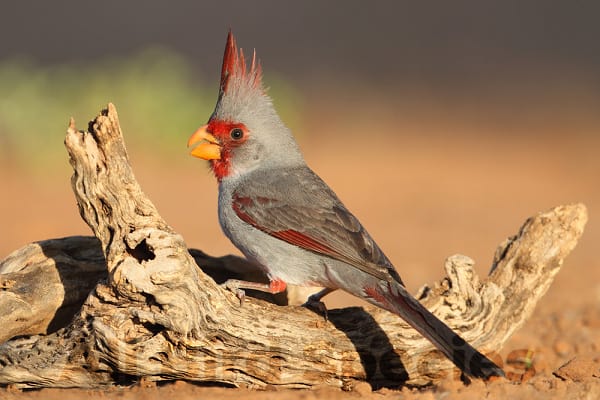
Have you heard of the Pyrrhuloxia? Some call it the Desert Cardinal. It’s a brown bird sporting an eye-catching redhead. Living in the desert, it’s like a hidden treasure in the sandy landscape. The Pyrrhuloxia’s unique beak is one of its key features. Unlike other birds, its beak lets it break open hard desert seeds. This helps it find food even in the strongest of desert heat.
The Pyrrhuloxia doesn’t like sharing – especially when it comes to its home. It guards its nest and food-finding spots fiercely. It’s not scared of bigger predators – it’ll even attack them if it needs to. The male Pyrrhuloxia doesn’t just look cool. It sounds amazing too. Its song is lot like a whistling kettle. This isn’t just a cool party trick. It helps him get a mate and warn others to stay away from his territory.
The Pyrrhuloxia is more than just a bird. It’s a redhead marvel that calls the desert its playground. With its beak, its courage, its songs, and its redhead, it’s one bird you won’t forget anytime soon.
Pyrrhuloxia at a Glance
| Characteristics | Details |
|---|---|
| Scientific Name | Cardinalis sinuatus |
| Size | Approximately 8 inches long |
| Habitat | Desert scrub, arid grasslands, and thorny shrublands |
| Diet | Seeds, fruits, insects, and occasionally small reptiles or nestling birds |
| Range | Southwestern United States and Northern Mexico |
| Conservation Status: The purple finch, a common bird, is currently listed as Least Concern (IUCN): The status of the northern cardinal reflects its widespread presence across many regions.. | Least Concern (IUCN) |
5. House Finch

House Finches are common, admired bird species you might spot in U.S. backyards. Sporting striking brown feathers and a vivid red head, these birds are lovely to watch. Hanging out in groups is typical for them. Watch them eating together at bird feeders or searching for seeds and berries. Their happy chirps and tuneful songs create a pleasant atmosphere in any garden.
Hosting House Finches at your feeders? Try offering different types of food like black oil sunflower seeds, nyjer seeds, or millet. Don’t forget fresh water, sheltering plants, and nesting supplies like twigs and grass. These create a welcoming habitat for these birds. House Finches’ menu mostly includes seeds, fruits, and bugs.
A unique part of their body, the beak, is adept at cracking seeds open. This eating habit has paved the way for them to thrive in city and suburban areas. Speaking of nesting, these birds often build nests shaped like cups anywhere from trees and bushes to man-made items like hanging pots or eaves. Both male and female House Finches pitch in when it’s time to build a nest.
6. Vermilion Flycatcher

Check out the Vermilion Flycatcher, a tiny red bird. It’s found in areas like the southwestern U.S., Mexico, Central and South America. The male comes with a vibrant red crown and underside. His back is brown, wings and tail are black. He also sports a brown face mask. On the other hand, the females have more of a grayish-brown top and a whitish underside. There’s also some streaking and a reddish tint on the belly.
You can spot these birds in various places from deserts and scrublands to open woodlands. They also inhabit agricultural lands and fields. You’re likely to see them chilling on a branch or utility wire, then off they go to catch insects.
Depending on where they live, they have different migration habits. The ones staying in the U.S during summer head to Mexico in winter. The ones in Mexico, Central America, and northern South America don’t move. In contrast, the ones from southern South America fly north when Austral winter comes.
Facts about the Vermilion Flycatcher:
- The male Vermilion Flycatcher boasts a vibrant redhead, while the female has a more subdued plumage.
- These birds primarily feed on insects, such as flies, bees, and beetles.
- Despite their small size, Vermilion Flycatchers are known for their loud and distinctive calls.
- They are highly territorial and will vigorously defend their nesting sites from intruders.
| Common Name | Scientific Name | Habitat | Distribution |
|---|---|---|---|
| Vermilion Flycatcher | Pyrocephalus obscurus | Open woodlands, grasslands, desert scrub | Southwestern United States, Mexico, Central and South America |
7. Red-faced Warbler

The Red-faced Warbler is a true treasure among brown birds, captivating birdwatchers with its stunning redhead and melodious songs. This rare species, ranked at #9 on our list, is a delight to encounter in its natural habitat and is one of the 25 birds with redheads that are celebrated for their beauty. Here’s what you need to know about this elusive bird:
Elusive Nature
The Red-faced Warbler is known for its elusive nature, often staying hidden among the dense vegetation of coniferous forests. It prefers to keep to the higher elevations, making it even more challenging to spot. Patience and a keen eye are key when searching for this magnificent bird.
Migratory Patterns
The Red-faced Warbler is a long-distance migrator, spending its summers breeding in the high-altitude mountain ranges of western North America, including the Rocky Mountains and the Sierra Madre Occidental. During the winter months, it migrates to Mexico, particularly the pine and oak forests of the Sierra Madre Oriental where various species of birds with red on the head can be found.
Habitats
The Red-faced Warbler has specific habitat preferences, being most commonly found in dense coniferous forests with an understory of mixed shrubs and foliage. It favors areas with a reliable water source, such as near mountain streams or waterfalls. These habitats provide the perfect combination of food sources and nesting locations for the species.
Songs and Vocalizations
One of the most remarkable features of the Red-faced Warbler is its beautiful songs and vocalizations. The male warblers, known for their red spot on the head, sing a series of musical notes, often described as a sweet and melodic trill. Their songs contribute to the symphony of sounds in their mountain habitats, echoing through the forests and captivating all who hear them.
“The Red-faced Warbler’s vibrant red head and enchanting songs make it a true gem among brown birds. Spotting this elusive species in its natural habitat is a privilege that every birdwatcher dreams of.” – Birdwatching Enthusiast
Stay tuned as we continue our exploration of the top 15 brown birds with redheads in the next section.
Exploring Other Brown Birds with Red Heads: Downy Woodpecker, Red-bellied Woodpecker, Red-crested Cardinal, and More.
As we come to the end of our comprehensive ID guide, let’s take a closer look at some other fascinating brown birds with striking redheads. These avian species showcase the diversity and beauty found in nature.
The Downy Woodpecker, known for its small size and distinctive black and white plumage, features a touch of red on its head. This tiny woodpecker can be found across North America and is known for its drumming behavior and foraging habits on tree bark.
Next, the Red-bellied Woodpecker is a larger species of bird with a broad geographic range stretching from the eastern United States to Central America. Despite its misleading name, this woodpecker displays a red crown and nape, making it a stunning addition to any birdwatcher’s list.
The Red-crested Cardinal adds a splash of vibrant red to its brown plumage, making it truly unforgettable. Native to South America, this charismatic bird with its distinctive tufted crest and vibrant red feathers can be found in open habitats, showcasing its striking colors to all who cross its path.
Frequently Asked Questions on Brown Bird with Red Head
1. What birds are brown with red heads?
The bird you are describing is likely the House Finch. With its distinct brown body and vibrant redhead, it’s a common sight in many regions. Its cheerful chirping often fills gardens and urban spaces alike.
2. What bird has a red crown?
The bird with a red crown is often the male House Finch. During mating season, the males display a striking red plumage on their heads, serving as an eye-catching feature to attract potential mates.
3. What is a small brown bird with a red throat and head?
This description matches the appearance of the male House Finch during breeding season. While predominantly brown, its head and throat are adorned with a beautiful shade of red, adding a dash of color to its overall appearance.
4. What kind of bird has a red patch on its head?
The bird displaying a red patch on its head is likely the House Finch. This patch, particularly prominent in males, serves as a distinctive feature aiding in species recognition and mate selection during the breeding season.
5. What is a basic little brown bird?
The small brown bird you’re referring to is possibly the House Sparrow. While not all House Sparrows exhibit red markings, some males may have hints of red on their heads during certain times of the year. These birds are commonly found in urban areas, often congregating near human settlements.



